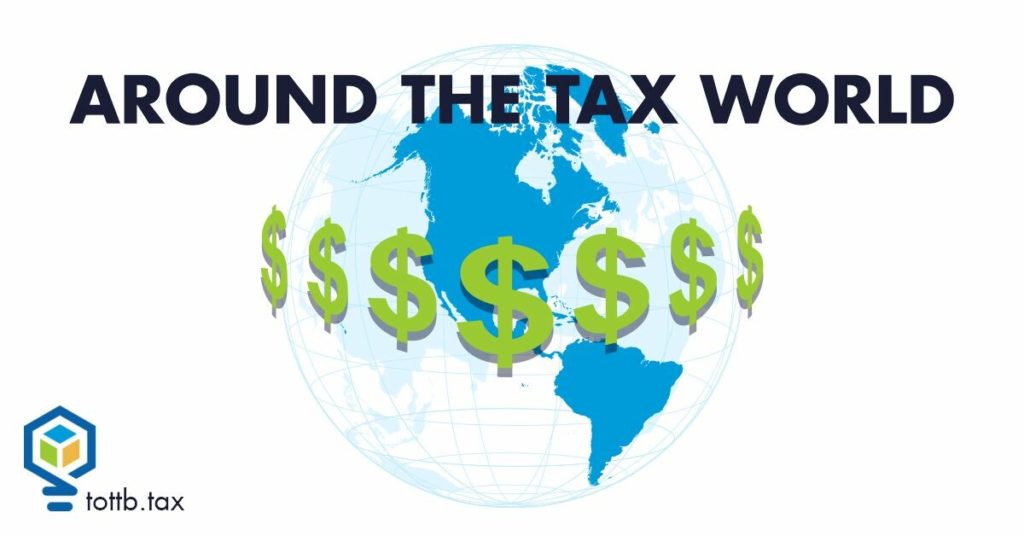
At Around the Tax World, you can find out all about what’s going on in the wonderful, worldwide world of tax. Every month, we’ll feature a few mini-articles on what’s been going on in the world when it comes to tax, and fully available for viewing even if you don’t have a subscription.
If you wish to subscribe and gain access to all articles on the site, be sure to check out the benefits of doing so here!
Check out what’s happening all around the world of tax!
In The Headlines
- Is DeepSeek the wave of the future of A.I.—or a threat to data security? Chinese artificial intelligence startup DeepSeek launched its new reasoning model R1 in late January and seemingly disrupted the U.S. stock market overnight. Investors’ predictions on the impact of DeepSeek led to companies like Nvidia seeing record-breaking stock market drops. Why the sudden shift? DeepSeek’s model differs from other popular AI tools, such as OpenAI, and the company claims its model both outperforms OpenAI and costs dramatically less to build. By way of comparison, top AI creators like OpenAI and Google are investing $1 trillion in their ongoing research and development, while DeepSeek states that it cost only $5.6 million to train. Meanwhile, DeepSeek has also been facing scrutiny over a recent discovery that the company inadvertently exposed over a million lines of sensitive data to the open internet. After U.S. cybersecurity firm Wiz posted about this data problem, DeepSeek secured the data in about an hour. However, security experts expressed concern about the oversight and the ongoing safety of the new AI tool.
- The U.S. GDP grew by 2.3% at the end of 2024, culminating in an unexpectedly solid year. Over the course of 2024, America’s gross domestic product—the total value of goods and services provided by the U.S.—increased by 2.5%, much better than forecasted. Though performance in the fourth quarter was lower than the third quarter (which came in at 3.1%), the overall results benefited from strong consumer spending, low unemployment, and wage growth. Consumer spending rose at a 4.2% annual rate from October through the end of 2024, and after-tax income increased at a 2.8% rate. At the same time, consumer prices have been on the rise, and the impact on inflation is uncertain in light of possible policy shifts toward increased tariffs and federal spending freezes. In 2025, business owners and taxpayers overall will need to look out for rising mortgage rates and continued high interest rates.
- Automakers are anticipating the impact on Trump’s rollback of EV initiatives. Former President Joe Biden set ambitious goals for increasing the use of electric vehicles, aiming for 50% of new vehicles sold in the U.S. to be battery-powered by 2035. As President Donald Trump took the helm, one of his first acts was to repeal the 50% EV target. While the move is symbolic, the actual effects on consumers and automakers is currently unclear. As of the end of January, EV-related tax credits and state and federal emissions rules remain intact. The next step in rolling back the emphasis on EVs would likely be to revoke emissions standards and fuel economy requirements, both of which incentivize automakers to manufacture and sell more electric vehicles than they might normally. However, this process could take months, since the EPA must first propose adjustments, then wait on a mandatory public comment period, and finally incorporate the public’s feedback into its changes.
What's New In The Tax World?
Will Trump’s $4 trillion tax cut plan prevail? Not without progress on reducing the national deficit
As one of his first moves in office, President Trump is urging Congress to extend the soon-to-be-expired provisions from his 2017 Tax Cuts and Jobs Act (TCJA). The renewal of these tax measures—which include a higher standard deduction, lower income tax rates for certain brackets, and a limit on state and local tax (SALT) deductions—is projected to cost over $4 trillion. A recent meeting of U.S. House Republicans failed to result in an agreement as a number of fiscally-focused lawmakers insisted that the plan must reduce the federal deficit. These hardliners may prevent a tax deal from going forward unless it addresses their concerns about the nation’s growing $36 trillion debt.
Republicans currently hold only a slight majority in the House, holding 218 out of 435 seats. This means that if only a couple of conservative representatives hold out, the GOP will not have enough votes to pass a new bill—assuming that Democrats stand united in opposing the bill. This is currently the situation with the TCJA extension. A number of the holdouts are members of the ultraconservative House Freedom Caucus. This congressional sub-group is advocating for a $3 trillion reduction in federal spending over the next decade and indicated that they would not vote in favor of a plan that failed to identify at least $1.5 trillion in cuts. Despite voting in favor of other parts of Trump’s agenda, the Freedom Caucus also voted against Trump’s attempt to eliminate the federal government’s statutory debt ceiling.
President Trump is also continuing to advocate for the elimination of federal taxes on workers’ tips, overtime pay, and Social Security benefits. To fund these tax cuts, House Republicans have discussed cutting spending on Medicaid and Affordable Care Act health insurance subsidies. Trump himself has ruled out the option of cutting Medicare and Social Security programs for seniors, though these two programs comprise about a third of the $6.75 trillion federal budget. However, the idea of reducing health care funding has a number of Republican and Democratic lawmakers concerned about the impact on their constituents.
State-By-State Updates
- Idaho lawmakers aim to tackle rising property taxes. Recent surveys show that Idaho taxpayers consider the cost of housing and property taxes their top issues. Sponsored by House Speaker Mike Moyle, Idaho’s House Revenue and Taxation Committee will review a new bill that would make a one-time $50 million payment to the state’s homeowners property tax relief fund. The bill would also send $50 million each year to Idaho’s school district facilities fund to help with new buildings and renovations, which are currently paid for through state property taxes. Property taxes also pay for highways, sewers, libraries, police, and fire and emergency services. The Idaho Legislature will also be reviewing bills that would reduce the state corporate and individual income tax rates and increase the sales tax credit on groceries.
- Indiana’s new governor speaks to plans to cut property taxes and provide tax relief for retirees and farmers. Governor Mike Braun is proposing a cap on annual property tax increases, limiting hikes to no more than 3%. This would apply to all property types including homesteads. Certain taxpayers would benefit from an even lower cap of 2%, such as homeowners aged 65 or older, families with minor children, and low-income households. The bill would also increase the homestead deduction for houses that are valued at less than $125,000. Lastly, the proposal includes a new property tax transparency portal to be launched by 2026. In Indiana, property tax funds go to communities instead of the state. This means Braun must also resolve the question of how to preserve funding for schools, police, and fire services.
- Michigan taxpayers may benefit from both federal and state-level earned income tax credits. For 2023, residents of Michigan received a higher-than-average federal EITC check: an average of $2,813 compared to the national average of $2,742. Even this number falls far below the maximum credit available of $7,830. Low-income taxpayers and families with three or more qualifying children may be eligible for the maximum amount. Additionally, the state of Michigan offers its own earned income tax credit. The state credit is a 30% match of the amount received through the federal EITC. For 2024, the maximum amount available is $2,349. For 2023, over 653,000 Michigan taxpayers received the state EITC with an average of $836 per check.
- New Jersey is expanding its property tax relief benefits. Seniors aged 65 and older and disabled homeowners will soon be able to apply online for three property-tax relief programs: Anchor benefits, the Senior Freeze program, and Stay NJ. New Jersey has set aside $3 billion to fund these direct property-tax relief programs. The combined application can be downloaded online, and paper copies will also be mailed to over 1 million households across the state. Other homeowners and renters may receive automatic eligibility letters for the next round of Anchor benefits, while others can still apply to determine their eligibility. Stay NJ is a new program, set to be launched this year, that ensures seniors will see an up to 50% reduction in their property tax bills. The first payments are scheduled for early 2026. The deadline to apply is October 31.
Tax Planning Tips
Avoid an audit by making sure these important forms are submitted. In the rush to submit taxes before the deadline, taxpayers may overlook key tax forms and unknowingly submit an incomplete return to the IRS. This could delay processing of your tax return, delay any refunds, or even trigger an audit. W-2s are the most common income tax forms, but many taxpayers will also look out for 1099s to ensure they are reporting all taxable income. This can include 1099-G for unemployment income, 1099-NEC for contract or gig economy work, and 1099-R for retirement plan distributions. If you are eligible for a tax deduction, you may need a 1098 for mortgage interest, 1098-E to report your student loan interest, or 1098-T for education tax breaks. Forms 5498 and 5498-SA help you to substantiate deductions for individual retirement account contributions or health savings account deposits, respectively. Lastly, you may need paperwork not supplied by the IRS to support claims for charitable gifts, childcare expenses, or property taxes owed. Taxpayers should check both their mailboxes and online accounts for the forms they will need.
Do your due diligence when claiming the child tax credit—or risk a significant delay with your tax refund. The child tax credit can provide a much-needed boost to a family. The current version, applicable to 2024 returns, is worth up to $2,000 for each eligible child under age 17 for households under the income limit. Of the maximum amount, up to $1,700 is refundable, which means families can receive a payout even if they do not owe taxes.
However, delays can occur when taxpayers do not know the eligibility requirements. To qualify, the child claimed must be no older than 17 at the end of the tax year. The child must also be a dependent on the filer’s tax return, must have lived with them for more than half of the year, and must have a qualifying relationship to the taxpayer. A refund could also be delayed if the taxpayer fails to include a Social Security number for themselves or their children. For newborns, it can take one to six weeks from application to receive a Social Security number. Taxpayers should request a filing extension rather than attempt to claim the child tax credit without the needed Social Security numbers.
NOT A MEMBER YET?

SUBSCRIBE TO GET ALL OF OUR
GREAT ARTICLES AND RESOURCES!
CURRENT EDITION

Leaving the United States, Part III: Dual Citizenship
In Part I of this three-part series, we discussed the implications and taxes for American expatriates. In Part II we turned our attention to renouncing citizenship. Here in Part III, we will consider the halfway point of dual citizenship. And as you would expect, taxes are a serious consideration.

Reflecting On Rothing
I have been dissatisfied with most of the articles that I have read about what I call Rothing, i.e. foregoing a deduction for retirement savings with the prospect of tax-free distributions in the future or taking the tax hit on a deferred account to convert it to a tax-free account. The articles generally have a pro-Roth bias. Suze Orman, for example, swears by Roths. They also tend to not have numbers in them. What I am going to do here is to reflect on the idea of Rothing and discuss what I see as some key numbers. I’m not going to dive deep into technical issues.

Considering a Historic Building for Your Business? These Tax Credits are Good News
Historic buildings make a beautiful location for doing business. Unfortunately, many of them may seem out of the price range of small business owners. But, that’s not necessarily the case. The state and federal governments have an interest in preserving these properties, and they are willing to give you tax credits for buying and restoring a historic building. The credits reimburse a large proportion of your restoration costs. This really is a great incentive to go for a building that will give your company a unique and professional feel.

